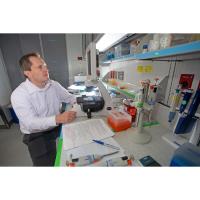USA Scientist Receives $1 Million from National Science Foundation
to Study Salmonella Survival
MOBILE, Ala. (Sept. 15, 2022) – A grant from the National Science Foundation will help scientists at the University of South Alabama improve the ability to combat agricultural diseases and foodborne illness outbreaks caused by Salmonella bacteria.
Salmonella live in the intestines of animals and humans, and people commonly are infected by consuming food or water that has been contaminated by feces. Symptoms of infection include diarrhea, fever and abdominal cramps. According to the Centers for Disease Control and Prevention (CDC), antibiotic resistance is increasing in Salmonella, which can limit treatment options for people with severe infections.
Glen Borchert, Ph.D., associate professor of pharmacology at the Frederick P. Whiddon College of Medicine, was awarded $998,655 to study the survival of Salmonella during cellular stress.
“The ability of certain species of nematodes, vascular plants and bacteria to survive desiccation (or extreme dehydration) for extended periods is a particularly striking example of the ability of cells to adapt to and survive even the most drastic environmental fluctuations,” said Borchert, principal investigator of the project.
Importantly, several groups have now shown that bacterial small noncoding RNAs (sRNAs) are frequently associated with stress and often contribute to survival during environmental challenges, such as desiccation or nutrient starvation, he said.
Bacteria have two principal strategies for survival during cellular stress. The first is the active expression of molecular tools capable of dealing with specific stressors. The second strategy is the generation of persister cells, which are comparatively metabolically dormant cells capable of prolonged survival in harsh environments.
“In either event, mounting evidence suggests that sRNAs represent key regulators of Salmonella stress survival,” Borchert said. “Understanding what drives the decision between active stress resistance and persister dormancy can significantly improve our ability to combat a number of societal challenges such as antibiotic resistance, foodborne illness outbreaks and agricultural diseases.”
The CDC estimates Salmonella causes about 1.35 million illnesses, 26,500 hospitalizations and 420 deaths in the United States every year.



